Spanish voice generation is a powerful tool for reaching a diverse audience across all 21 Spanish-speaking countries. With AI, creators can develop marketing content in regional accents—such as Castilian, Mexican, or Latin American Spanish—and produce voice overs for podcasts like Radio Ambulante, TV shows like La Casa de Papel, and educational materials. In this guide, we’ll explore how to create engaging, high-quality Spanish voice overs with AI and highlight the top AI voice generators for the best results.
About Spanish: A Language Spoken Worldwide
Spanish is a global language, spoken by over 580 million people worldwide, including nearly 500 million native speakers and spans multiple countries, including Spain, most of Central and South America, and parts of the United States. Notably, Spanish dialects can vary significantly across regions, from Spain’s Castilian to Latin American varieties in Mexico, Colombia, and Argentina, each with distinct phonetics, vocabulary, and slang. An effective Spanish AI voice generator should offer dialect-specific options to ensure that the accent and tone resonate authentically with audiences from different Spanish-speaking regions. Here are just a few examples of how certain dialects of Spanish differ:
Spain Spanish
In Spain, Castilian Spanish is predominant, featuring the distinctive "th" sound for the letters "c" and "z" (e.g., "gracias" is pronounced as "gra-thi-as"). The vocabulary in Castilian Spanish also includes unique regional words, such as "coche" for "car," whereas in Latin America, "carro" is more commonly used.
Mexico Spanish
Mexican Spanish is widely understood across Latin America due to the popularity of Mexican media and is characterized by a neutral accent that avoids strong regionalisms. Mexican Spanish also includes unique vocabulary, like “chido” (cool) and “güey” (buddy or dude), and informal pronouns like “vosotros” are not used.
Colombia Spanish
Colombian Spanish, especially the accent from Bogotá, is known for its clarity and neutrality. However, Colombian Spanish also includes unique local expressions, such as “parce” (friend) and “bacano” (cool). It’s often chosen for broadcasting due to its intelligibility across Spanish-speaking countries.
Argentina Spanish
Argentine Spanish, or Rioplatense Spanish, has a distinct intonation influenced by Italian immigration, giving it a rhythmic flow. Argentina uses "vos" instead of "tú" and has unique pronunciations, such as the “sh” sound for “ll” and “y” (e.g., “lluvia” is pronounced “shuvia”). Common phrases like “che” (a conversational filler) and “boludo” (a friendly term for “dude” or “fool”) are distinctly Argentine.
United States Spanish
In the U.S., Spanish is spoken by over 40 million people, with dialects reflecting the diverse Latin American backgrounds of Hispanic communities. Spanish AI voice generators aimed at U.S. Spanish audiences should balance a neutral accent with regional adaptability, given the mix of Mexican, Puerto Rican, Cuban, and other Latin American influences.
Types of Spanish AI Voice Generation
When it comes to Spanish AI voice generation, advancements in technology have opened up exciting possibilities for producing realistic and culturally nuanced Spanish voices. Whether you're a content creator, business owner, or language enthusiast, AI-powered voice tools can help you reach a broader audience, engage listeners, and bridge communication gaps through both AI text to speech (TTS) and voice cloning. Let’s take a look at both so you can determine which is right for you:
Realistic Text to Speech Spanish Voices
Spanish text to speech generators convert text into spoken audio using advanced AI algorithms. These text to speech tools generate natural-sounding AI voices that can be customized to different accents, such as Mexican or European Spanish, and provide lifelike voice overs suitable for various applications. Text to speech software is beneficial for content creators who require high-quality audio content quickly, such as for YouTube videos, audiobooks, and e-learning materials.
Spanish Voice Cloning
Voice cloning AI technology allows for the creation of custom Spanish voices by mimicking a specific person’s voice, tone, and speaking style. This artificial intelligence is especially valuable for continuity in series content or brand-specific voice overs, where maintaining a consistent voice is crucial. For example, content creators like Fede Vigevani or Kimberly Loaiza who are widely known can use this technology to clone their voice and create voice overs that sound just like them instantly to save time with editing.
Benefits of Spanish AI Voice Generators
Unlike many languages, Spanish has a wide range of variations—such as the distinct accents of Spain, Mexico, Argentina, and Colombia—each with unique vocabulary, pronunciation, and intonation. High-quality Spanish AI voice generators can be tailored to these regional nuances, ensuring that listeners feel a stronger, more authentic connection to the content. Spanish AI voice generators are also helpful for these reasons:
- Affordability: Hiring voice actors for each project, especially those who are familiar with the specific dialect you need, can be costly. However Spanish TTS generators offer an affordable alternative, especially for projects requiring frequent updates or multiple versions.
- Scalability: With AI voice generators, businesses can scale audio production to meet high demand. Whether for corporate training materials for Spanish companies like Agencia EFE, or audiobooks like Cien años de soledad, Spanish TTS generators can handle volume seamlessly without losing quality.
- Natural female and male voices: Top Spanish TTS generators, like Speechify Studio, offer diverse male and female voices, allowing brands to choose voices that best align with their target audiences.
- Regional Spanish AI voice options: Spanish AI voice generators that offer regional accents enable content creators to reach more culturally relevant audiences, providing localized experiences for specific Spanish-speaking demographics.
- Multilingual support: Many AI voice generators support multiple languages, including Spanish, Italian, Portuguese, and German, making it easy for companies to expand globally without sacrificing linguistic accuracy.
Best Spanish AI Voice Generator for Realistic Spanish AI Voices
Speechify Studio is among the top Spanish AI voice generators. Not only does the platform offer the most lifelike AI voices on the market but it also offers customizable features to take your Spanish voice projects to the next level. Here’s just a small look into what makes Speechify Studio the best AI voice generator for Spanish:
- Extensive library of lifelike text to speech AI voices: With over 200+ AI voices in various languages and accents, including but not limited to Spanish, English, Polish, Korean, Tamil, Russian, Chinese, Japanese, Italian, Arabic, German, Greek, French, Portuguese, Hindi, and more, Speechify Studio provides some of the most realistic and lifelike voices available on the market.
- Region-specific Spanish accents: Speechify Studio’s accent generator offers region-specific Spanish accents, allowing users to target audiences in Argentina, Bolivia, Chile, Columbia, Costa Rica, Cuba, the Dominican Republic, Ecuador, El Salvador, Equatorial Guinea, Guatemala, Honduras, Nicaragua, Panama, Peru, Puerto Rico, Paraguay, Spain, the United States, Uruguay, Venezuela, Europe, and Mexico with precision.
- AI voice cloning: Speechify Studio not only offers Spanish text to speech voice but also supports voice cloning, ideal for brands or content creators needing consistent voice overs. This feature enables users to create a custom Spanish voice that captures the unique sound and style of the original speaker.
- Precise customization and authentic nuances: Speechify Studio differentiates between masculine and feminine forms in Spanish, adjusting adjectives and verbs to match the intended gender accurately. This gender-specific feature brings a greater level of authenticity, enhancing the listening experience for Spanish-speaking audiences.
- Multi-speaker support: With multi-speaker support, Speechify Studio enables users to add multiple voices in various accents or languages in a single project. This feature is particularly useful for storytelling or educational content where varied voices enrich the narrative.
- API integration: Speechify Studio provides a text to speech API solution that integrates with other platforms, making it ideal for businesses seeking seamless deployment of voice overs.
- Real-time voice generation: Speechify offers real-time voice generation with low latency, ensuring fast turnaround for dynamic content needs.
Speechify Studio Spanish AI Voice Generator Understands Spanish
Speechify Studio's Spanish AI voice generator offers a remarkably nuanced approach to Spanish pronunciation, tailored to different dialects. The platform’s advanced AI can distinguish between regional pronunciations and can even adjust for subtle variations within each region. This makes the platform ideal for creating content that resonates with diverse Spanish-speaking audiences. Let’s explore just a few examples of how Speechify Studio ensures its Spanish AI voice generation is spot on:
- Vosotros vs. Ustedes: In Spain, informal plural forms like "vosotros" are widely used. For example, "You all eat" translates to "Vosotros coméis." However, in Latin America, "ustedes" is the standard, so it would be "Ustedes comen." Speechify Studio allows users to choose the appropriate dialect, ensuring the correct pronoun and verb conjugation for the target audience.
- The "Seseo" vs. "Ceceo" phenomenon: In Spain, particularly in regions like Madrid and Andalusia, "ceceo" is prevalent, meaning the “z” and “c” sounds before "e" or "i" are pronounced with a “th” sound. For example, “zapato” (shoe) is pronounced “TH-a-pa-to.” However, in most of Latin America, "seseo" is common, where "z" and "c" are pronounced with an “s” sound, as in “S-a-pa-to.” Speechify Studio adjusts to these regional differences, selecting either “ceceo” or “seseo” based on the dialect chosen.
- Vocabulary variations: Spanish vocabulary differs greatly between countries. For example: "Car" is “coche” in Spain but commonly “carro” in Mexico and “auto” in Argentina. Likewise, "Computer" is “ordenador” in Spain, whereas “computadora” is preferred in Latin America. Speechify Studio’s AI incorporates these vocabulary choices into the script, allowing for regionally appropriate terms based on the selected Spanish dialect, enhancing relatability and cultural accuracy.
- Aspiration of the "S" sound: In parts of the Caribbean, such as Puerto Rico and Cuba, as well as parts of southern Spain, there is a tendency to aspirate or even drop the "s" at the end of syllables. For example, "más" (more) might sound like “mah,” and "nosotros" (we) might sound like “no-sotroh.” Speechify Studio can replicate these subtle changes, making it ideal for audiences in these regions where the aspirated "s" is common.
- Pronunciation of "R" and "RR": Spanish speakers in regions like Puerto Rico and the Dominican Republic tend to soften or "liquidize" the “r” sound, pronouncing “perro” (dog) more like “peh-o” rather than the trilled “per-ro” in other regions. In contrast, the trilled "rr" is strong and prominent in places like Mexico. Speechify Studio can account for this by using a gentler "r" sound for Caribbean dialects or a more pronounced trill for audiences in mainland Latin America.
- Intonation and rhythm: The intonation in Spain often has a sharper, slightly faster rhythm, whereas Latin American Spanish, particularly Mexican and Colombian Spanish, tends to have a more neutral and steady rhythm. Caribbean Spanish, on the other hand, can have a more musical quality with a quicker pace and softened consonants. Speechify Studio’s AI voice generator adapts to these pacing and intonation patterns, giving the audio an authentic flow that aligns with the chosen dialect.
- Pronunciation of "J" and "G" sounds: The “j” sound in “jota” (J) or “g” in “gente” (people) is generally pronounced with a stronger, more guttural sound in Spain, similar to the "ch" in the German word “Bach.” In Mexico and most of Latin America, this sound is softer. For example, in Spain, “jamón” (ham) would sound closer to “khah-MON,” whereas in Latin America, it’s a lighter “hah-MON.” Speechify Studio adjusts this based on region to match the local pronunciation style.
Use Cases for Spanish AI Voice Generators
Since Speechify Studio offers a truly customized Spanish listening experience that feels both natural and respectful of regional diversity, it offers a wide range of use cases, including but not limited to:
Spanish AI Voice Generator for Audiobooks
Spanish audiobooks benefit greatly from AI voice generation by adding regional authenticity to each story. For instance, Storytel and Audible can use AI to create audiobooks with voices that adapt to Mexican, Argentine, or Castilian Spanish accents. This enables listeners to enjoy stories that feel culturally relevant and familiar, enhancing the audiobook experience for Spanish-speaking audiences worldwide.
Spanish AI Voice Generator for Podcasts
AI-generated Spanish voices allow podcasters to produce high-quality episodes quickly. For example, Leyendas Legendarias could use realistic Spanish TTS voices to narrate historical tales or add commentary to their episodes, saving production time while ensuring the voice over maintains the appropriate tone. Brands and individual podcasters can also offer multilingual versions, using AI to create seamless Spanish adaptations that broaden their reach.
Spanish AI Voice Generator for Product Demos
Spanish AI voice generators like Speechify Studio can make product demonstrations more accessible and engaging for Spanish-speaking customers. For instance, companies like Movistar in Spain or Telcel in Mexico can use natural AI Spanish voice overs in their product demo videos to guide users with clear, relatable instructions, fostering trust and improving customer satisfaction.
Spanish AI Voice Generator for Corporate Training
In multilingual work environments, Spanish AI voice generators are valuable for creating training content tailored to Spanish-speaking employees. Companies like Telefónica or BBVA could use custom Spanish TTS voices to develop accessible training modules, making onboarding and professional development more efficient and inclusive.
Spanish AI Voice Generator for Marketing Ads
Spanish AI voice generators enable brands to craft region-specific ads, capturing the nuances of various dialects. For example, a company like Coca-Cola España could use an Argentine-accent for an ad targeting that region, while choosing a Mexican-accented voice for a campaign in Mexico. Adjusting tone and language ensures ads resonate with local audiences, boosting engagement.
Spanish AI Voice Generator for YouTube Videos
YouTubers such as El Rubius or Yuya can use Spanish AI voice overs to localize their content or create additional content faster. By adding voice overs to tutorials, explainer videos, or vlogs, creators can increase accessibility, reaching diverse Spanish-speaking audiences and enhancing engagement on their channels.
Spanish AI Voice Generator for Social Media Videos
Spanish AI voice generators can help content creators and brands create short, catchy voice overs for platforms like TikTok or Instagram. Brands like Desigual or Bershka could use AI voice generators to quickly convert Spanish text into audio for dynamic, regionally targeted social media videos that capture viewers' attention and deliver their message effectively.
Spanish AI Voice Generator for Voice Assistants and IVR
Spanish AI voice generation enhances voice assistants and IVR systems, providing natural-sounding interactions that improve user experiences. Companies with Spanish-speaking clients, such as BBVA or Santander, can personalize their customer service and customer support by implementing Spanish AI voices that sound friendly and familiar to callers, increasing customer satisfaction and accessibility.
How to Use Speechify Studio’s Spanish Text to Speech AI Voice Generator
Using Speechify Studio’s AI voice generator is straightforward. Simply follow this step-by-step guide to create a Spanish Spanish text to speech AI voice over:
Start a new project: Click on "New Project" and select "VoiceOver."
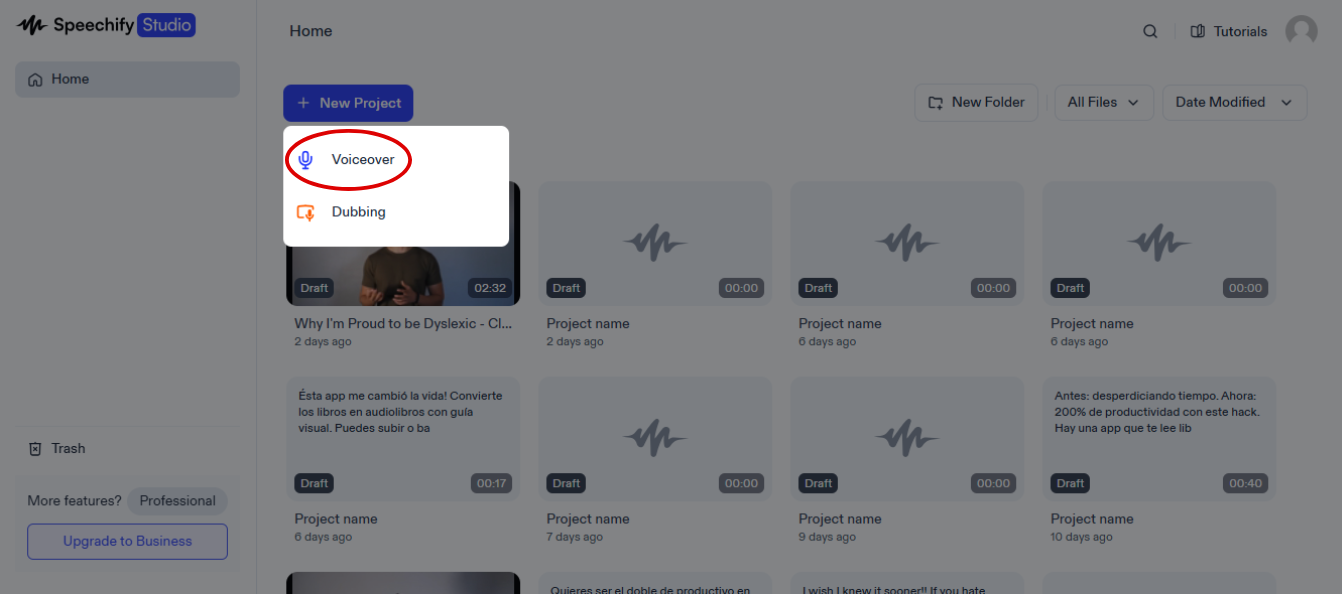
Import your script: Choose "Import" to upload your script, enabling automatic voice over generation.
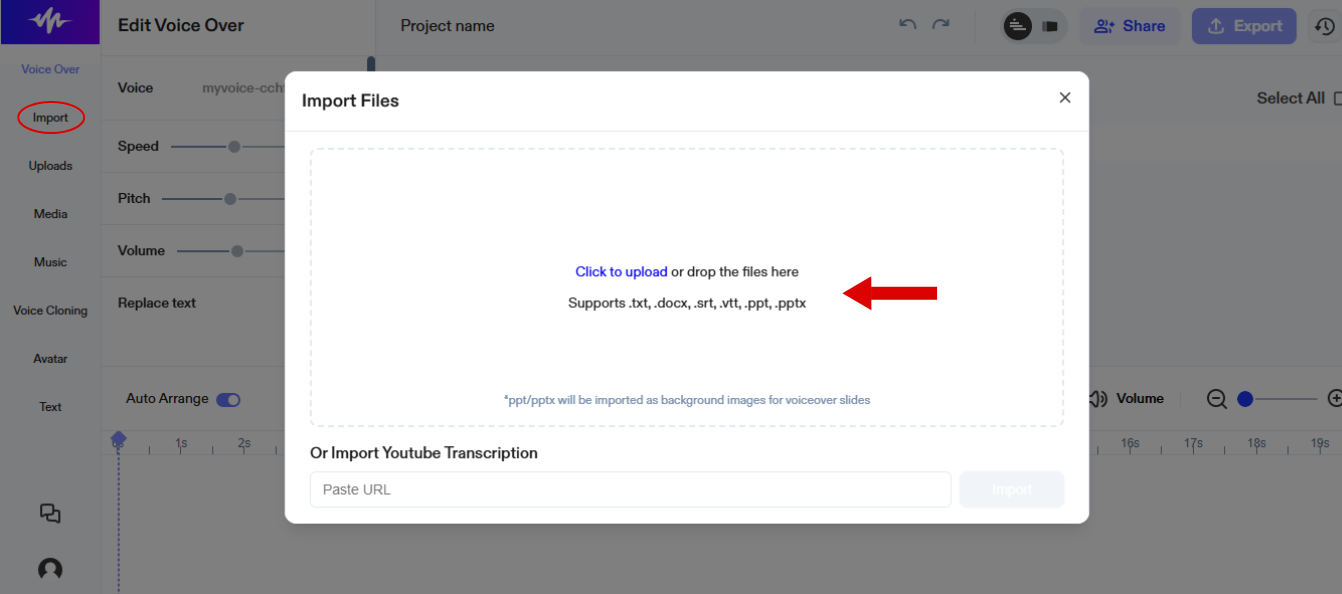
Select a voice: Tap the circle voice icon next to the script text to choose your preferred voice in Spanish.
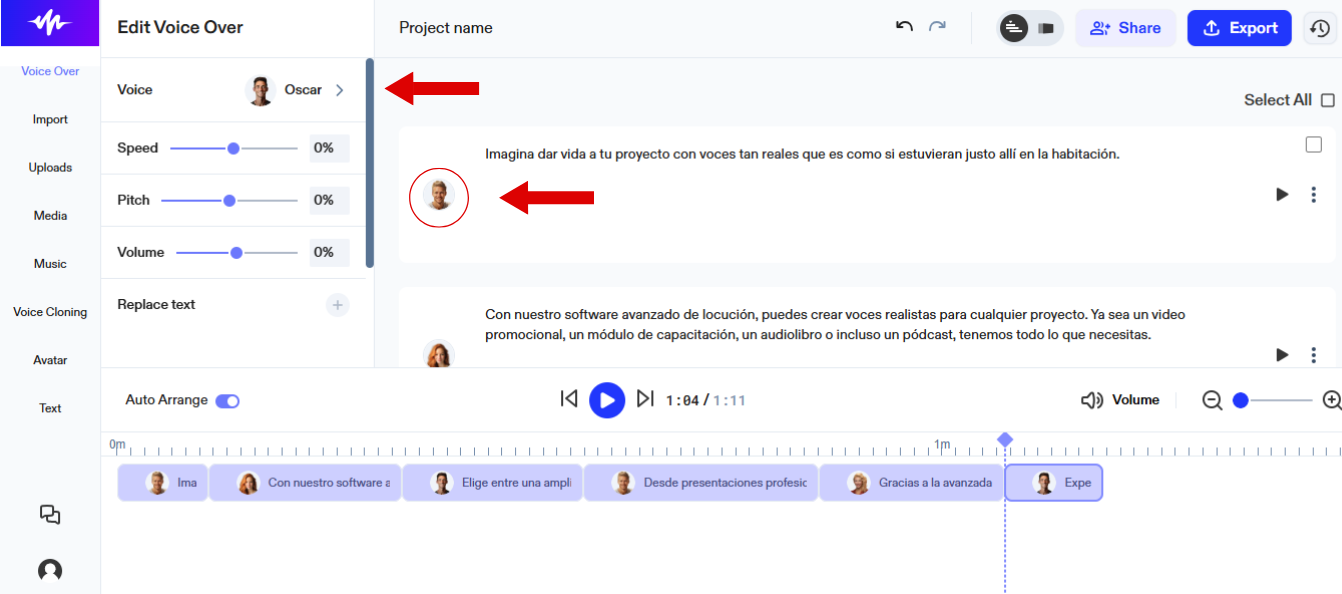
Add media: Click "Uploads" to add your video files or images. Alternatively, use "Media" or "Music" to incorporate stock footage or audio.
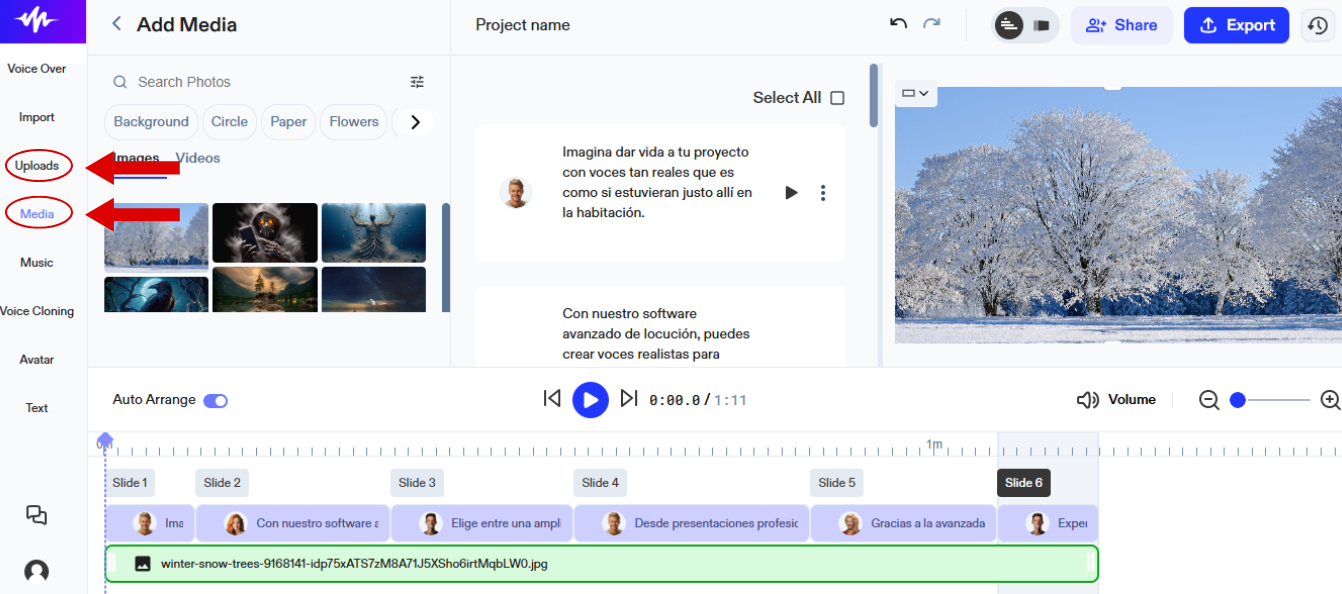
Edit your content: Under "VoiceOver," adjust pitch, tone, and pronunciation as needed. You can also drag and drop to edit your video footage or create AI avatars.
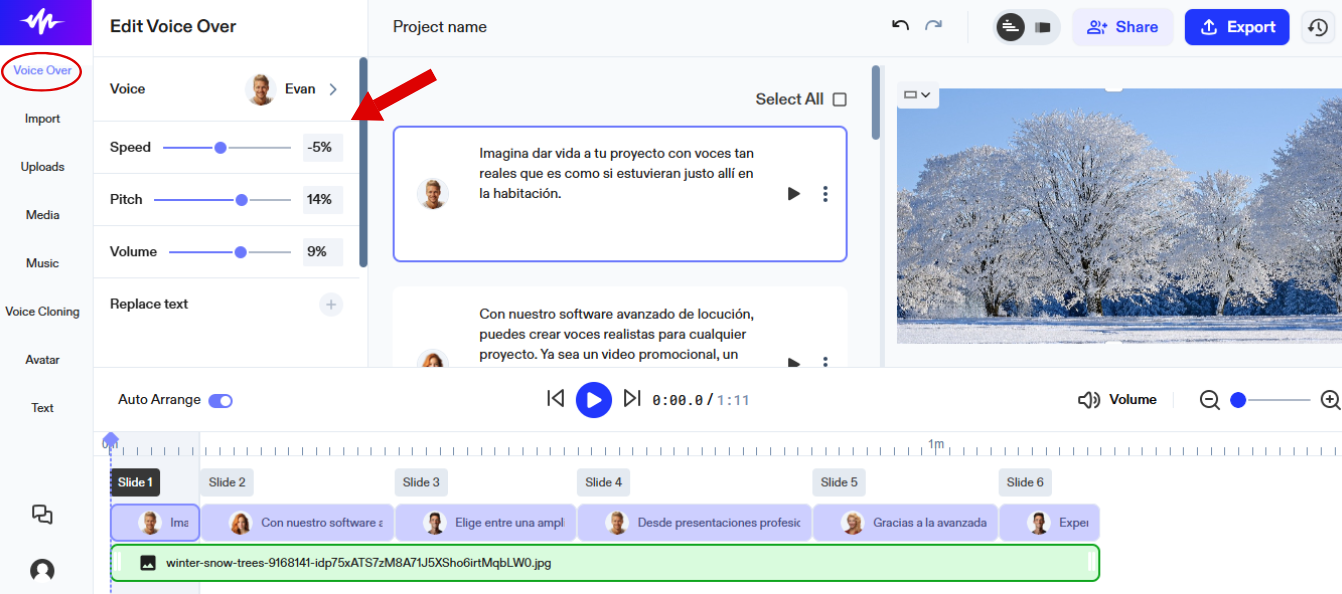
Export your project: Tap "Export" and select your desired file format, such as WAV or MP3.
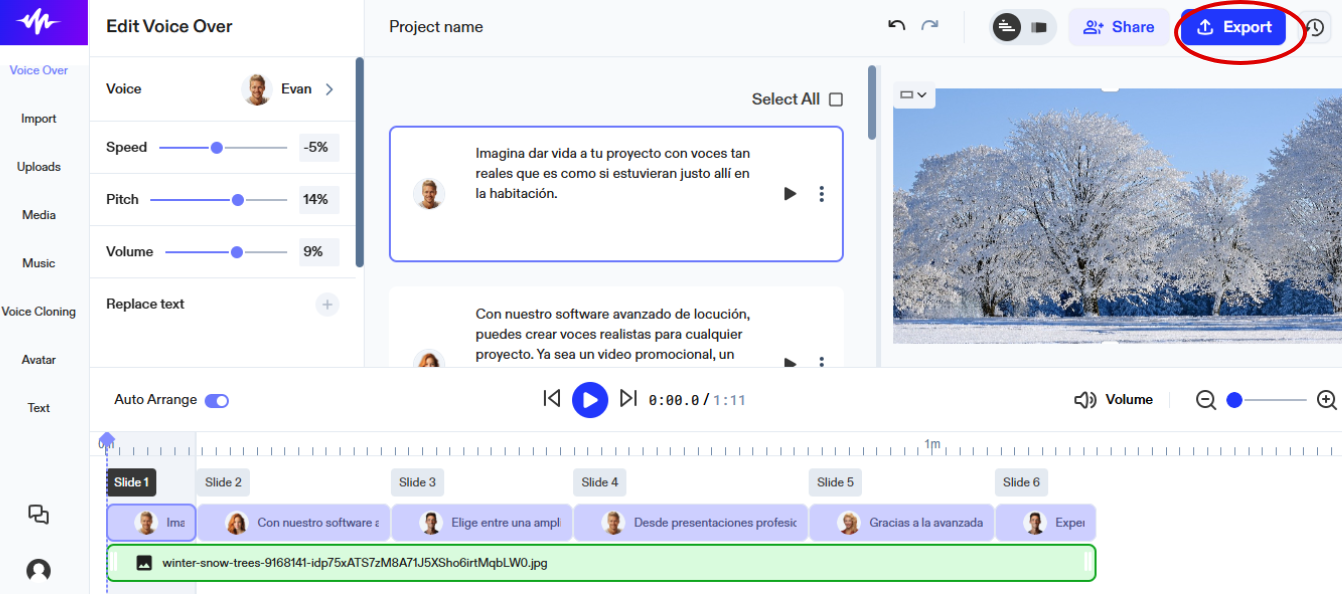
How to Use Speechify Studio’s Spanish Voice Cloning
Using Speechify Studio’s voice cloning feature is just as simple. Here’s a breakdown of how to create a unique Spanish AI voice based on your own voice:
Start a new project: Open Speechify Studio and select “New Project.” Choose “VoiceOver” from the options.

Initiate voice cloning: Tap on “Voice Cloning” and then select “Create New Voice Clone.”
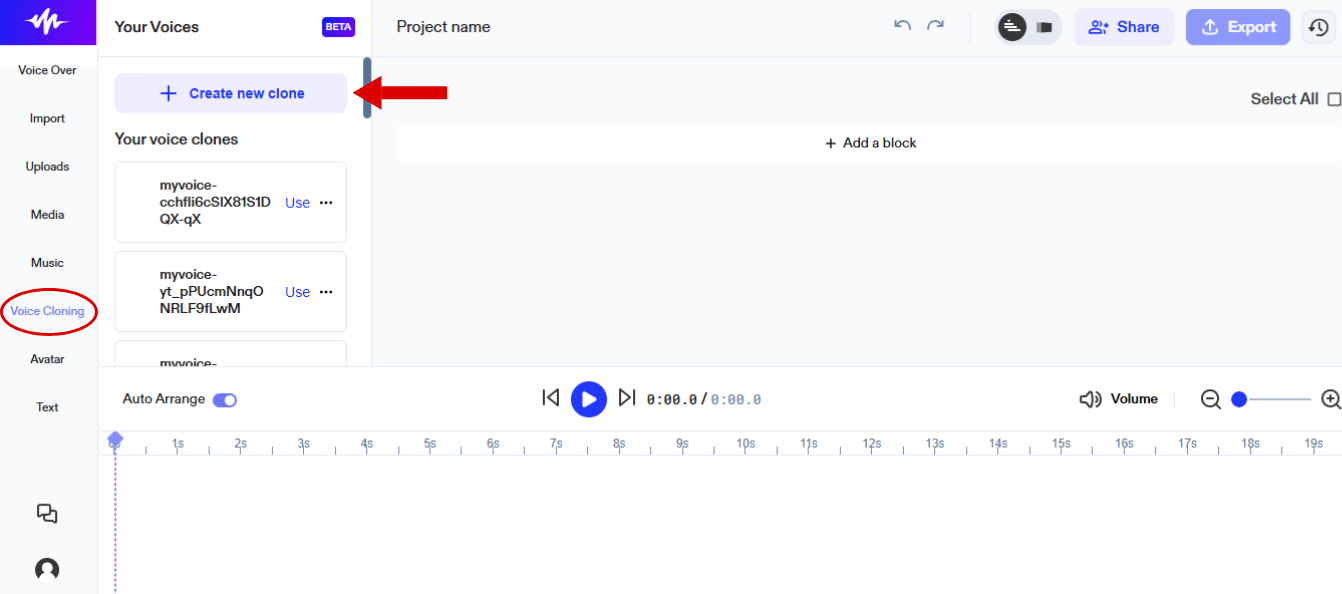
Record a sample: Record a 20-second audio clip of yourself speaking Spanish clearly without background noise. A live recording works best for accuracy rather than an uploaded audio file.
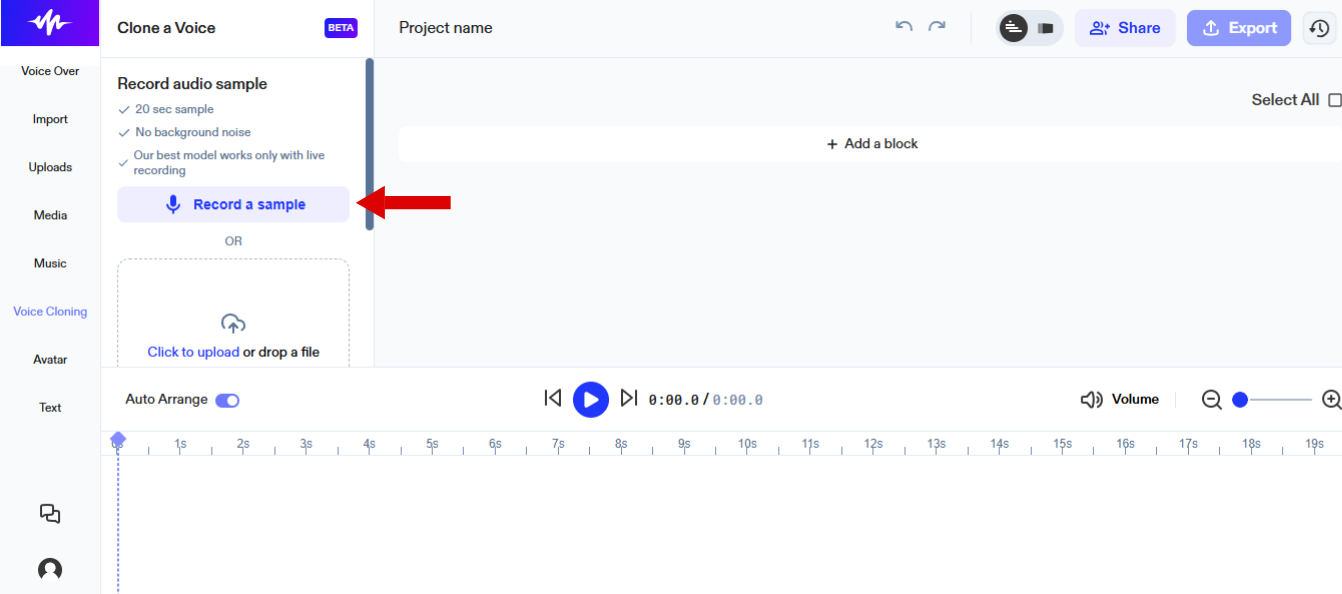
Generate your voice clone: Hit “Continue” and allow Speechify Studio to process and generate the new Spanish AI voice clone. Once created, this generated audio will be available for all future projects.
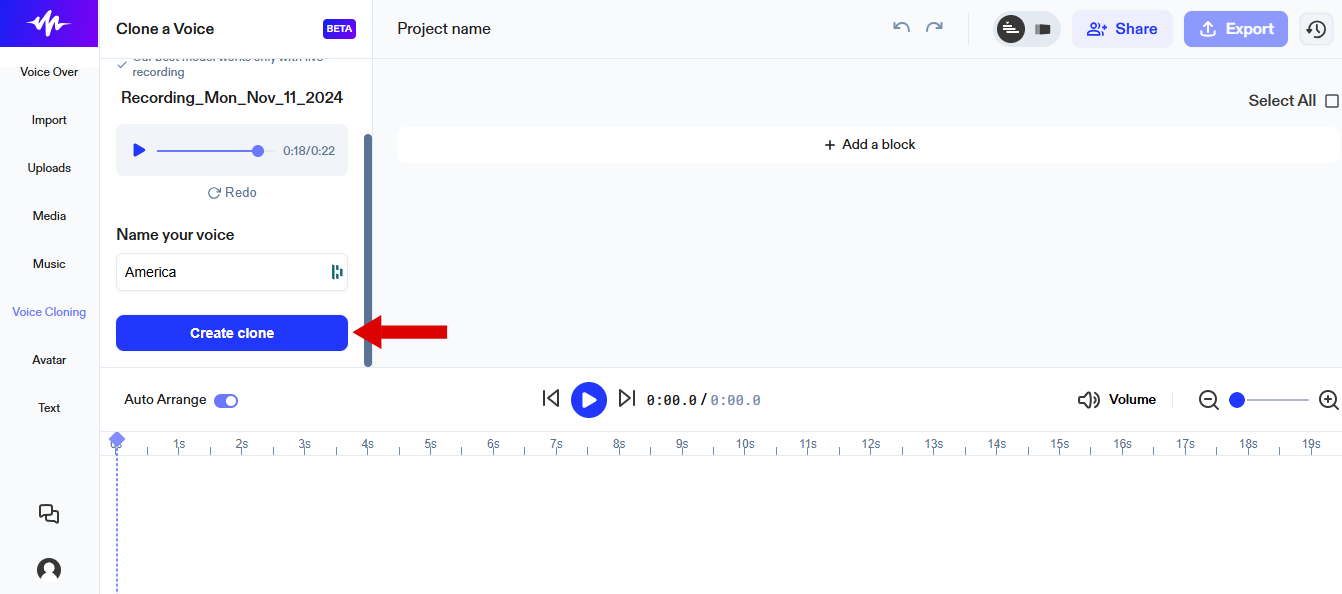
Apply your voice clone: To use your voice clone, follow the same steps as with an AI text to speech voice—upload your script and footage, select your voice clone, and Speechify Studio will create a complete AI voice over that sounds just like you.
Most Popular AI Voice Generators for Spanish
With the increasing demand for Spanish content choosing the right AI voice generator is crucial. While Speechify Studio is offers the most lifelike Spanish AI voice generator, here are a few more options to explore:
Speechify Studio
Speechify Studio offers users a comprehensive text to speech and voice over solution with a vast library of over 200 realistic voices across more than 150 languages and accents. Speechify Studio’s AI video editor is particularly powerful due to its advanced features, allowing granular adjustments in pitch, tone, pronunciation, and emphasis. This tool also includes the ability to auto-delete filler words as well as dub content, allowing users to produce high-quality content in Spanish or any of the other languages it supports. Users benefit from copyright-free music and video footage, as well as a text to speech API for seamless integration into other applications so you can reach a global audience.
Play.ht
Play.ht is a robust text to speech solution with a wide selection of 800 voices in 142 languages, including Spanish. Known for its custom phonetics and pronunciation options, this platform allows users to achieve a natural flow and accurate sound for complex scripts. Play.ht includes voice cloning, a text to voice editor, and support for creating engaging audio content in multiple languages, offering a versatile option for those seeking lifelike voice overs with customizable options.
ElevenLabs
ElevenLabs stands out with its emphasis on low-latency, high-quality AI voice cloning and dubbing features, available in 32 languages. With a streamlined approach to text to speech, ElevenLabs offers various TTS voice options, making it a practical choice for dubbing Spanish content where real-time or near-instantaneous output is essential.
Descript
Descript combines powerful editing tools with broadcast-quality audio at 44.1K Hz and is geared towards simplifying voice editing through its text-based approach. Users can edit video content by editing transcripts directly, making it an efficient choice for Spanish content creation. Descript offers nine voices and 22 languages, with automatic filler word removal, allowing users to produce clean, high-quality audio without manual post-processing.
LOVO
LOVO brings a unique focus on emotional depth, offering over 500 voices in 100 languages, including Spanish. The platform's features include pronunciation editing, emotion options, and voice cloning, allowing users to add sound effects for enhanced storytelling. LOVO’s emotion editing ranges from cheerful to serious, making it an ideal tool for Spanish content requiring expressive voice overs.
Listnr
Listnr is known for its extensive library of over 900 voices in 142+ languages. It includes tools like voice cloning, voice changers, and podcast-specific features, including recording, editing, and hosting. This versatility makes Listnr a great choice for Spanish podcast creators looking to streamline production with advanced voice features.
Murf.ai
Murf offers 120+ voices across 20 languages, including Spanish, with a focus on natural-sounding adjustments. It allows users to edit breaths, pauses, and pronunciation, and it also auto-deletes filler words for polished results. With Murf’s voice cloning capabilities, Spanish content creators can create high-quality, natural-sounding narrations with minimal effort.
NaturalReader
NaturalReader provides a wide range of 200+ voices in 27 languages, with pronunciation, emphasis, and pitch editing tools. It supports commercial use and offers emotional options from cheerful to angry, making it suitable for various Spanish content needs, from commercial narrations to storytelling.
Synthesys
Synthesys offers a robust library with 370+ voices in 140 languages, making it a powerful tool for voice over professionals who need reliable, high-quality options in Spanish. It includes unlimited downloads and is cloud-based, with an extensive voice library for producing content at scale.
WellSaid Labs
WellSaid Labs offers a select range of 50 voices with various accents and styles, along with real-time editing. Its tools include adding pauses and unlimited retakes, which provide users with flexibility in creating polished, natural-sounding Spanish voice overs.
Respeecher
Respeecher specializes in capturing fine speech details and provides dubbing and voice cloning options for any language, including Spanish. Its web app and API support integration into other platforms, making it ideal for those who need high-quality voice replication in Spanish.
Synthesia
Synthesia integrates text to speech with 200 voices across 120 languages and supports text to video with AI avatars. This platform also offers a voice cloning add-on, enabling dynamic Spanish video content with lifelike avatars for immersive experiences.
Resemble AI
Resemble AI features voice cloning, voice changer, emotion control, and a deepfake detector across 60 languages. While its per-second pricing is on the higher side, the platform is robust, providing extensive options for nuanced Spanish voice generation with emotion control.
Clipchamp
Clipchamp offers 170 voices in 80 languages and includes unique features like caption generation and a speaking coach with real-time feedback. Its user-friendly tools make it a good choice for Spanish content creators who want to improve their delivery with real-time assistance.
Narakeet
Narakeet offers a substantial selection of 600 AI voices in 90 languages, including 11 different Spanish accents. Integrating with providers like Amazon Polly and Microsoft, it also includes a slides-to-video conversion feature, making it a versatile choice for Spanish content creators seeking integrated multimedia options.
VEED
VEED supports 50 languages, offering auto-subtitles, translation, and audio cleaning for clear, high-quality output. With adjustments in tone and speed, VEED is great for creators looking to refine the Spanish content with minimal post-production effort.
Conclusion
In conclusion, the Spanish AI voice generator market has evolved to meet the diverse needs of Spanish-speaking audiences around the world. With advanced tools like Speechify Studio, creators now have access to realistic, region-specific voices, voice cloning, and multilingual support, ensuring a high degree of accuracy and cultural relevance in their content. From audiobooks to corporate training, podcasts, and social media, AI-driven Spanish voice overs provide both scalability and affordability, allowing brands and creators to produce engaging audio content efficiently.
FAQ
What is the Spanish AI voice translator?
The Spanish AI voice translator in Speechify Studio allows you to seamlessly convert text into lifelike Spanish audio, perfect for multilingual content creation.
Is there a free Spanish AI voice generator?
Yes, Speechify Studio offers a free pricing tier with access to a Spanish AI voice generator for simple text to speech needs without the need for a credit card.
What is the best Spanish voice translator?
Speechify Studio is widely considered one of the best Spanish voice translators, offering realistic and versatile Spanish AI voices for various uses.
Can ElevenLabs do Spanish?
While ElevenLabs supports Spanish, Speechify Studio provides an extensive range of high-quality Spanish AI voices with enhanced accuracy and natural sound.
Which is the best Spanish AI voice generator?
Speechify Studio stands out as one of the best Spanish AI voice generators, especially for delivering high-quality, customizable voices.
Do you support Spanish TTS?
Absolutely, Speechify Studio supports Spanish TTS, delivering a range of options for engaging and natural-sounding Spanish audio.
Which AI voice generator offers the most natural-sounding Spanish voices?
Speechify Studio is renowned for offering some of the most natural-sounding Spanish voices in the AI voice generation market.





